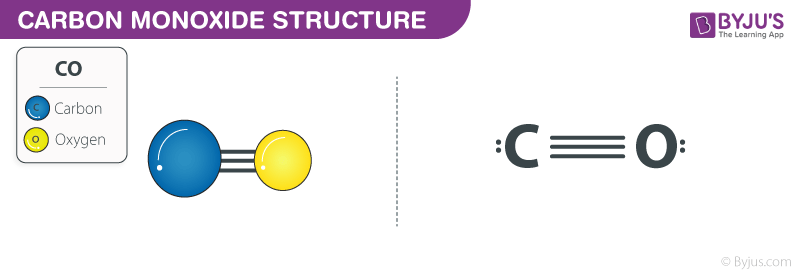What is Carbon monoxide?
Carbon monoxide is a colorless gas and is represented as CO.
It has one carbon atom which is covalently bonded to one oxygen atom. It is also known as Carbonic oxide or Carbon oxide. It is a toxic gas. It is odorless and has no taste. It is a poisonous gas which when inhaled causes asphyxiation and damage of the Central Nervous System. When it combines with hemoglobin it forms carboxyhemoglobin. It is widely used as an industrial fuel for various operations.
Properties of Carbon monoxide – CO
| CO | Carbon monoxide |
| Molecular Weight/ Molar Mass | 28.010 g/mol |
| Density | 789 kg/m3 |
| Boiling Point | −191.5 °C |
| Melting Point | −205.02 °C |
Carbon monoxide Structure – CO

Carbon monoxide Structure – CO
CO Uses (Carbon monoxide)
- It is used in the production of methanol
- It is used in the packaging of fresh meat products such as fish, beef etc
- It is used as a strong reducing agent
- It is used in infrared lasers
- It is used in beverages and food like jam and cola to acidify them
- It is used to remove rust from the surface to metals.
Frequently Asked Questions
Why is carbon monoxide dangerous?
Carbon monoxide when breathed is harmful because it displaces oxygen in the blood and deprives oxygen from the heart, brain and other vital organs. In minutes, massive quantities of CO will overtake you without warning, causing you to lose consciousness and suffocate. A particular danger to the fetuses is also the CO poisoning.
What appliances can cause carbon monoxide?
Carbon monoxide is a combustion by-product, present any time fuel is burned. Popular home appliances, such as gas or oil furnaces, gas refrigerators, gas clothing dryers, gas ranges, gas water heaters or space heaters, fireplaces, charcoal grills, and wood burning stoves are made.
How does carbon monoxide affect the human body?
Carbon monoxide has positive and adverse effects on humans. Increased levels of carbon monoxide in red blood cells decrease the amount of oxygen hemoglobin carries throughout the body. The effect is that vital organs like the brain, nervous tissues, and the heart don’t get enough oxygen to function properly.
Can you recover from carbon monoxide?
The majority of people who experience moderate carbon monoxide poisoning rapidly recover when they step into fresh air. Moderate or extreme contact of carbon monoxide induces impaired vision, confusion, unconsciousness, hallucinations, chest pain, shortness of breath, low blood pressure and coma.
How do you get rid of carbon monoxide?
Breathing in pure oxygen is the only way to treat the CO poisoning. The procedure raises blood oxygen levels and helps keep CO out of the body. The doctor will put an oxygen mask over the mouth and nose and ask you to inhale it.
Also Read:
| Citric Acid | Calcium Hydroxide |
| Carbonic Acid | Ethylene Glycol |
Learn more about the chemical behavior and importance of Carbon monoxide (CO) with the expert faculties at BYJU’S – India’s largest education company.




Comments